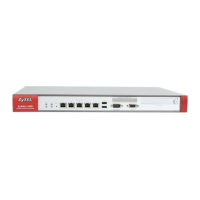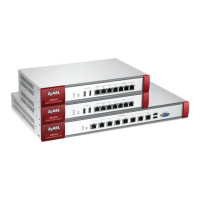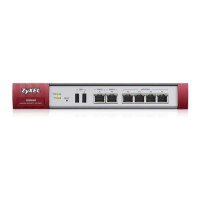Chapter 10 Interfaces
ZyWALL/USG Series User’s Guide
337
Figure 239 Configuration > Network > Interface > LAG
Each field is described in the following table.
Table 119 Configuration > Network > Interface > LAG
LABEL DESCRIPTION
Configuration
Add Click this to create a new entry.
Edit Double-click an entry or select it and click Edit to open a screen where you can modify
the entry’s settings.
Remove To remove an entry, select it and click Remove. The ZyWALL/USG confirms you want
to remove it before doing so.
Activate To turn on an entry, select it and click Activate.
Inactivate To turn off an entry, select it and click Inactivate.
Create Virtual
Interface
To open the screen where you can create a virtual interface, select an interface and
click Create Virtual Interface.
Object References Select an entry and click Object Reference to open a screen that shows which
settings use the entry.
# This field is a sequential value, and it is not associated with any interface.
Status This icon is lit when the entry is active and dimmed when the entry is inactive.
Name This field displays the name of the LAG interface.
Mode Mode refers to whether the LAG is acting as follows:
• active-backup where only one slave in the LAG interface is active and another
slave becomes active only if the active slave fails.
• 802.3ad (IEEE 802.3ad Dynamic link aggregation) where Link Aggregation Control
Protocol (LACP) negotiates automatic combining of links and balances the traffic
load across the LAG link by sending LACP packets to the directly connected device
that also implements LACP. The slaves must have the same speed and duplex
settings.
• balance-alb (adaptive load balancing) where traffic is distributed according to the
current load on each slave by ARP negotiation. Incoming traffic is received by the
current slave. If the receiving slave fails, another slave takes over the MAC address
of the failed receiving slave.
IP Address This field displays the current IP address of the LAG interface. If the IP address is
0.0.0.0, the interface does not have an IP address yet.
This screen also shows whether the IP address is a static IP address (STATIC) or
dynamically assigned (DHCP). IP addresses are always static in virtual interfaces.
Slaves A slave is a physical Ethernet interface that is a member of a LAG. Slaves do not have
an IP Address and in some cases share the same MAC address. This field displays the
member Ethernet interfaces and VLAN interfaces in the LAG. It is blank for virtual
interfaces.

